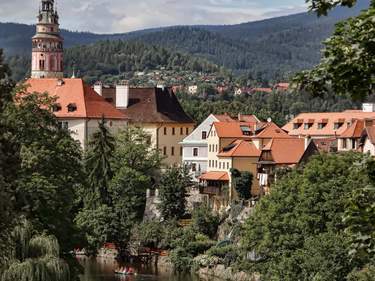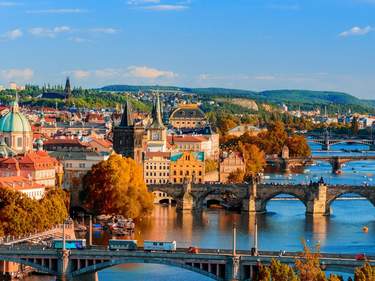“Here’s a Nokia programmed with emergency contacts, and your budget for the next 24 hours: 20 koruna (70p). Now I just need your clothes.”
We say our goodbyes to Tereza and head into the busy station.
Mindful of his responsibility, Robert ushers me across the concourse – though, as we pass a ticket machine, he instinctively checks the slot for coins. We ride countless trains, and eventually arrive in Smíchov – an industrialised district mixing faded glory – of dilapidated factories and synagogues – with a newfound style made up of glass malls and boutique restaurants.
“There,” Robert said, pointing to the ČKD Tatra factory, which produced trams for Stalin’s Communist party in the late 1940s. Robert’s enthusiasm for the railroads is boundless and provides a unique way into Czech history and culture.
And we’re off again, passing Staropramen (Prague’s largest brewery) to reach the Salvation Army, where Robert works.
It’s not clear what we are doing – Robert’s explanations are sometimes cryptic – then, I’m shepherded towards a pyramid of cardboard boxes, which we, and half a dozen other employees, haul downstairs for the charity’s office move.
Robert is one of nine guides currently working with Pragulic. They earn a fixed fee per tour plus tips, with the rest reinvested into running costs.
“But it’s not just about finding employment,” Tereza explained earlier. “We offer guides a range of development programs, from teaching English to building self-confidence.”
Via a dose of Czech politics we arrive at Cibulka, a pretty but otherwise unremarkable park, dotted with crumbling Baroque statues. While stopping by an 1840s lookout tower, Robert reveals that we will be sleeping on the floor of his late father’s flat. Soon he will have to leave when the property is sold. “To where?” I ask. “Who knows,” he replies, before changing the subject.
Around 10pm, I clear plastic bottles and newspapers from the hallway and try, unsuccessfully, to sleep.
He keeps his living area – a floor-to-ceiling mass of motley possessions and rubbish – in a state of disarray. Around 10pm, I clear plastic bottles and newspapers from the hallway and try, unsuccessfully, to sleep.
Emerging in the early hours we take the first tram to district 5, where, in stark contrast, well-tended mansions and luxury apartments overlook the city. It’s a lovely view, but we are here to deliver newspapers – Robert’s 6am round earns him a bit of extra cash.
It’s on these prosperous streets that Robert speaks candidly about his descent into homelessness. After his uncle sold the family home in 2006, Robert found himself sleeping rough in the capital. “Unfortunately he married a woman that would like me dead,” he says whilst forcing open a frozen mailbox.
Critics claim that tagging along with society's poorest is more voyeurism than tourism. But Robert, for one, believes his new work has helped get his life back on track.
With a now empty delivery bag and our 24 hours complete, we head back to Prague station to collect my belongings and, sadly, part ways.
Critics claim that tagging along with society’s poorest is more voyeurism than tourism. Perhaps that’s true. But the extent to which these tours are welcomed should be decided by the guides themselves.
Robert, for one, believes his new, if unorthodox, work has helped get his life back on track, “I couldn’t be more grateful.”
Beyond Prague: homeless tour guides in other cities
Beyond Pragulic there are plenty of similar initiatives where homeless tour guides are employed to offer an alternative view of their city. Here, we’ve picked four of our favourites:
1. Shades Tours, Vienna
Launched in 2015, Shades Tours' aim here is to change the way tourists experience Vienna, whilst reducing the stigma associated with homeless people. As founder Perrine Schober puts it: “Nobody leaves with the same picture of homelessness they harbored before.”
Professional and often personal two-hour tours (available in English and German) introduce small groups to a hidden side of the city via soup kitchens and emergency night shelters. You’ll learn how the Viennese social system works and gain insight into the many “shades” of homelessness that exist.

_listing_1640546826392.jpeg)







